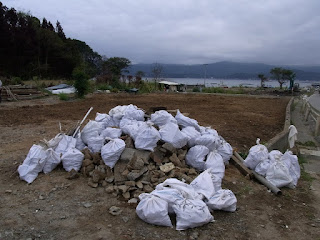The volunteer system has been quite well organised. Buses (or cars) of volunteers come to the visitors centre each day, get allocated a task and then go out and do (or try to do) it. Finding locations in Japan is difficult as it is a system based on numbering blocks and sections with in blocks rather than street names and numbers and directions are often given by landmarks. In the absence of landmarks, it could be difficult to find the place, forutnately the bus driver is well experienced in the area.
A lot of the work being done by volunteers is clearing land of remaining rubble - broken bits of concrete, asphalt, roof tiles, glass and crockery, as well as rocks that have been washed down from higher ground. Very occasionally we came across an unbroken plate or tea cup which would be put aside. It was as much as a mark of respect for it's survivor skills as it was that it may be useful to someone. It was hard not to wonder where it had been swept from, who had drunk from it and whether or not they were OK. At one stage I came across a middle school student's school tracksuit top, the name clearly embroidered on the front, as per Japanese custom. It had been there a while and the police said to leave it as is... It's hard not to wonder... but there is little point in doing so as it changes nothing.
 |
| Rubble being cleared - glass and enamel are bagged together, rocks, asphalt, concrete and tiles together, metal, and 'other'. Larger rocks and concrete are not bagged. |
1 comment:
tears are welling up reading this. It would have been difficult to retain composure while holding the track suit.
Post a Comment